In 2006, with drillers poking gas wells into the Barnett Shale beneath Fort Worth as fast as they could get mineral leases signed, Fort Worth granted a permit for the first well in this city of another kind – a hole not for taking minerals out, but for forcing back underground the millions of gallons of toxic, salty wastewater left over every time another gas well gets “frac’d.”
 Four years later, these disposal wells are still a liquid hot potato in North Texas and indeed in many other parts of the state. Fort Worth still has only one such well, on East First Street, because of a several-times-renewed moratorium. But in other towns and rural areas around Texas, citizens groups are fighting such wells before the Railroad Commission, in city hall meetings, and at the courthouse.
Four years later, these disposal wells are still a liquid hot potato in North Texas and indeed in many other parts of the state. Fort Worth still has only one such well, on East First Street, because of a several-times-renewed moratorium. But in other towns and rural areas around Texas, citizens groups are fighting such wells before the Railroad Commission, in city hall meetings, and at the courthouse.
Like nuclear power, natural gas is a fuel touted as clean on the front end but with major questions left unanswered about how to get rid of its byproducts on the other end. Railroad Commission and Environmental Protection Agency officials point out that more than 50,000 of these wells have been permitted around the state and that they’ve been used by the oil and gas and other industries for decades. The Railroad Commission, historically, has turned down few applications for disposal well permits, even when opponents fill the hearing room – and the hearing record – with concerns about things like groundwater dangers and heavy truck traffic on rural or neighborhood roads.
In some cases, such wells have been the site of fires and explosions and have been blamed for repeated instances of groundwater contamination, though the state agency says no such contamination has ever been proven. An EPA official said that agency has seen a dramatic surge in complaints about disposal wells and has asked the Railroad Commission to toughen its rules and change its permitting process, with only partial success. A state appellate court has raked the commission over the coals for its narrow approach toward protecting the public interest in such applications. The agency’s refusal to place more requirements on disposal well operators is one reason Fort Worth’s moratorium has remained in place.
“There is no protection for the citizens,” said Tim Lane, a University of North Texas psychologist who is dealing with fumes, noise, lights, runoff, and other concerns from a disposal well next to his small ranch in Cooke County. “From everything we see, their [the Railroad Commission’s] purpose is to protect the oil and gas industry from the public.”
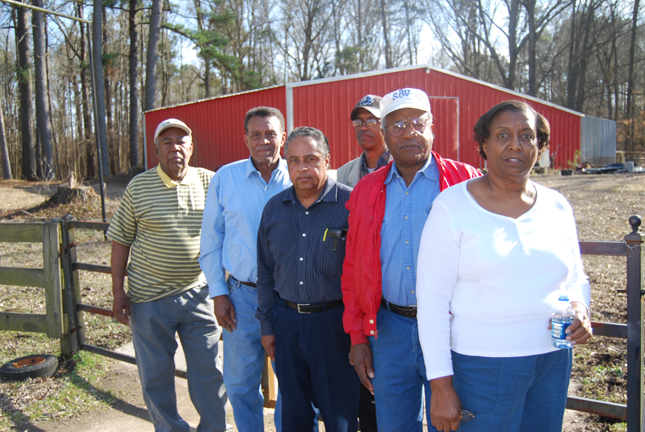 But Glenn Hess, part owner of that disposal well, said his operation is safe, legal, and provides a much-needed service. “Disposal wells are a necessary evil, if you want to call it that,” he said. The country needs natural gas, gas wells produce wastewater, “and it has to be disposed of somewhere.”
But Glenn Hess, part owner of that disposal well, said his operation is safe, legal, and provides a much-needed service. “Disposal wells are a necessary evil, if you want to call it that,” he said. The country needs natural gas, gas wells produce wastewater, “and it has to be disposed of somewhere.”
In Fort Worth, the city’s top environmental official said he expects to be ready by summer to make recommendations about whether the city should make the disposal well moratorium permanent or take another route for handling drilling wastes.
Environmental management director Brian Boerner said one question the city has to consider is whether a permanent ban on disposal wells actually benefits the environment – if, in reaction, drillers and disposal companies simply go outside the city and put the well in anyway, in areas where the city has no power to set standards for safety, waste handling, cleanup, or anything else.
Boerner, who in the past has characterized disposal wells as the last option the city should consider, said recently that even though few Fort Worth citizens get water from wells, the city has a responsibility to think about those who do.
The decision may come down in part to that question of equity: Should Fort Worth, whose citizens are profiting – at least financially – from the drilling boom, continue to ship the vast majority of its drilling wastes to disposal wells outside the city limits, where rural and small-town residents end up enduring the heavy-truck traffic and threats to their environment?
Some regulators think drilling wastes ought to be disposed of on the drilling site, so that the same people who benefit also participate in the risks.
But if that were the rule, Fort Worth would end up with hundreds of disposal wells to go with its gas wells, in residential neighborhoods, near schools and parks and waterways.
In that case, local citizens might consider the experience of a little Panola County community called DeBerry, in far East Texas. There are more than 40 disposal wells in the county, and a few years ago, water from some private wells was found to be so polluted – including by the types of cancer-causing chemicals found in drilling waste fluids – that it was ruled unsafe for human consumption. The EPA paid for bottled water for the community for several years, and eventually the federal government also paid to connect the community to a public water supply. One disposal well thought by locals to be a source of the problem closed voluntarily, just before a hearing was scheduled. But the other is still operating and is seeking a permit to become a commercial disposal site. EPA officials said they are convinced that the disposal wells themselves did not contaminate the water around DeBerry, but that there is evidence that surface spills from the disposal operation may have played a part. Residents near the wells have been dealing for years with a 24-hour parade of massive tanker trucks coming and going just outside their fences, with fumes from well sites, and with questions about their water.
“It leaves citizens without money up against companies saying, ‘We’re doing this for your benefit,’ yet we see no benefit,” said the Rev. David Hudson, who has orchestrated the fight in DeBerry. “In some places, people are afraid of the oil and gas companies. If they fight them, they figure they are going to lose their couch, their car, their dog, their cat, whatever land they’ve got. When they’re driving, they pull over in the ditch because they’re afraid of these companies’ trucks.” One disposal well company manager called law enforcement to complain that Hudson was harassing her, because of inquiries and complaints he had filed with state and federal agencies.
If there is fear of the big companies, there’s an even bigger fear of the unknown – about whether it’s safe to drink the water, to breathe the air, and what the company on the other side of the fence is putting into the ground.
Because the oil and gas industry is exempt from most provisions of federal clean-air and clean-water laws, they are not now required to reveal what is in the fraccing fluids they use and dispose of – although there is growing pressure in Congress to inquire into that problem.
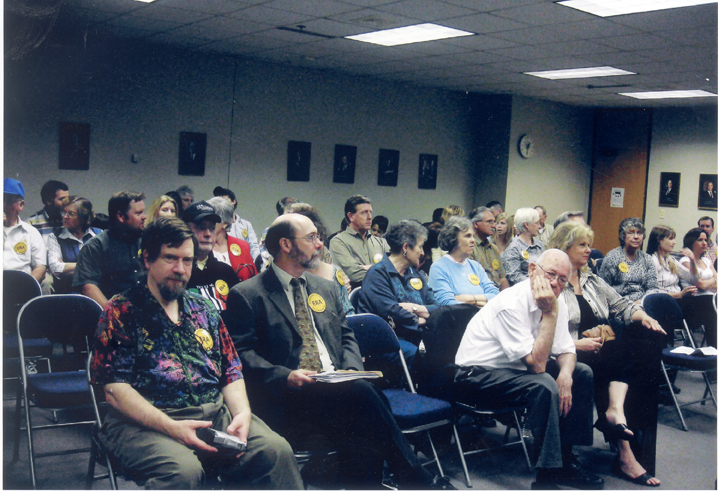 Those kinds of unanswered questions are the reason that the recently formed North Central Texas Communities Alliance and other groups want a moratorium on drilling and its attendant activities, like disposal wells.
Those kinds of unanswered questions are the reason that the recently formed North Central Texas Communities Alliance and other groups want a moratorium on drilling and its attendant activities, like disposal wells.
“The operative words here are ‘don’t know,’ ” said Louis McBee, an Eastside businessman, activist, and treasurer of the alliance. The city’s single disposal well is in his neighborhood. “I think the first step is to know what they’re putting in the ground. The rule should be, as long as we don’t know, you can’t put it in the ground.”
On East First Street in Fort Worth, in the Trinity River bottoms and not far from city ball fields and Gateway Park, a line of trucks leads the way to the city’s only current disposal well. The trucks could eventually be replaced, at least in part, by a “significant” pipeline to carry the so-called “saltwater” from up to a hundred Chesapeake Energy gas wells strung out along the Trinity from Beach Street east to Arlington.
Disposal well technology has been used by the oil and gas industry for decades. But the water-intensive nature of the hydraulic fracturing process used in shale drilling and the size of the boom itself have hugely increased the need for such wells, or for other disposal strategies.
Essentially, well operators drill down far below the strata at which fresh water is found, to formations like the Ellenburger that already hold intensely salty water.
What goes into wastewater from a gas well? The huge amounts of fresh water used at high pressure to fracture the shale to release the natural gas; the chemical soup of fraccing fluids that the drillers use to make the fraccing more efficient; some of the gas itself; and the extremely salty water, from ancient seabeds, that was originally trapped in the shale. The wastewater is often put through an evaporation process to reduce the amount that goes down the disposal well. And while the chemicals – like benzene and toluene – are a huge health concern, EPA officials and others also pointed out that it’s the salt component of “produced” water – thousands of times as salty as the sea – that can render the ground around a spill permanently useless for growing anything.
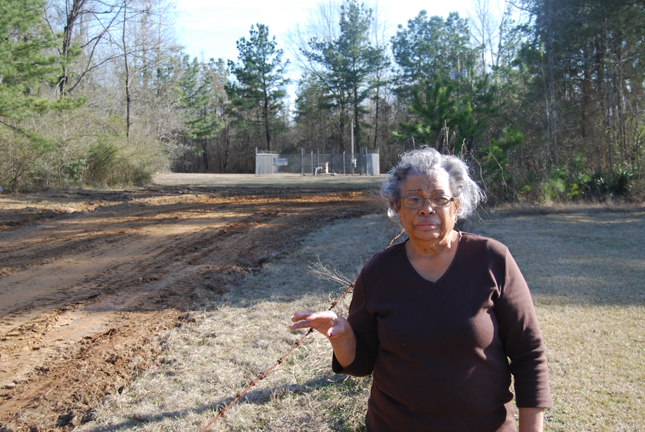 The Railroad Commission requires three layers of casings that are intended to protect fresh water sources underground from being contaminated. In conjunction with the Texas Commission on Environmental Quality, it decides how deep the well needs to be drilled to avoid groundwater contamination. Commercial wells are inspected once a year and private wells less regularly.
The Railroad Commission requires three layers of casings that are intended to protect fresh water sources underground from being contaminated. In conjunction with the Texas Commission on Environmental Quality, it decides how deep the well needs to be drilled to avoid groundwater contamination. Commercial wells are inspected once a year and private wells less regularly.
When an operator asks for a permit, according to the commission web site, the list of factors the commission considers is relatively short – whether the operator has a clean record, whether surrounding parties have been notified, whether the well has been designed adequately to protect groundwater, whether there are abandoned or improperly plugged oil or gas wells within at least a quarter-mile of the site.
On its web site, the commission states that there are “no known instances of ongoing groundwater contamination” due to saltwater activities in the Barnett Shale, a statement that draws anger from people whose water wells have been ruined, animals sickened, trees killed, and in some cases aquifers compromised when the only thing that changed in the neighborhood was the drilling of a gas well or a saltwater disposal well.
They aren’t the only ones unconvinced. “There are significant concerns” that saltwater disposal “will impact groundwater,” Boerner said. He also said that recycling technologies, which reduce the amount of wastewater that needs to be disposed of, can produce their own problems, because the high salt content clogs up filters almost immediately. If other old wells nearby are not properly plugged, they can become conduits through which the toxins and salt can get into groundwater and to the surface.
“What the Railroad Commission monitors is significantly different” from some of the things the city is concerned about, Boerner said, including ensuring that there is no dumping or leakage of toxic waste loads on the way to the disposal well, where wells could be located, hours of operation, landscaping, lighting, and additional monitoring.
The city quickly found out that one thing it couldn’t control is the depth to which the well must be drilled. As soon as the first well went in – the only one permitted before the moratorium – Boerner said, a permit for a second well was requested. But that application asked for a variance to allow the well to be drilled into a shallower formation than the Ellenburger, “and we were not comfortable with that.”
However, the Railroad Commission told the city, he said, that only the state could determine how deep the well needed to go. Rather than allow wells that city officials weren’t convinced were being drilled to the proper depth, Boerner said, the moratorium was instituted.
The EPA had also been concerned at the Railroad Commission’s failure to require that disposal wells in the Barnett Shale be drilled into the Ellenburger formation, which is considered to have plenty of capacity and to be well shielded from fresh water supplies.
Philip Dellinger, the head of the EPA’s Region 6 section that oversees groundwater and injection well issues, said his agency in recent years has made numerous recommendations to the Railroad Commission “directly out of our investigations on Barnett Shale issues.”
“Our biggest push to the Railroad Commission has been to take these disposal wells down to the Ellenburger formation, to get them out of the shallower zones,” he said. The commission declined to make that a hard-and-fast rule, he said, but did make changes to move in that direction.
According to information provided by the commission, “virtually all high-volume disposal wells” in the Barnett play are now drilled into the Ellenburger.
The disposal well operating next to their property keeps Tim Lane and his wife (and fellow psychologist) Donna Fleming awake on many nights. They worry about the runoff from the well site that flows across their property during periods of high water and drains into their stock tanks. They worry about what the well is doing to their property values and their ability to sell their land in the future. And oh yeah, they’re also awake because of the noise of huge diesel trucks backed up along their fenceline, revving their engines, and the bright lights that stay on at night.
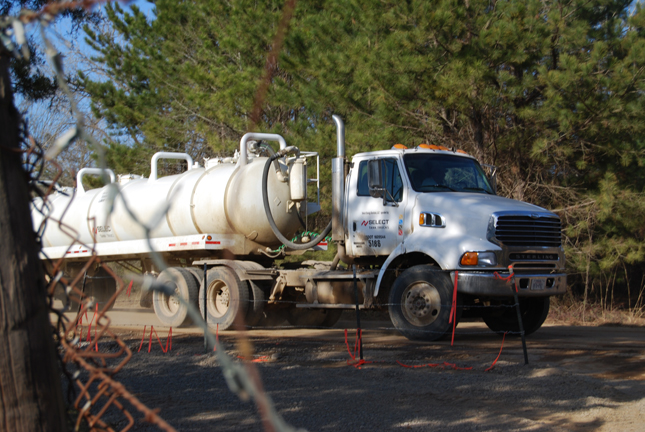 And the fumes. “I wouldn’t light a match outside sometimes, the petroleum fumes are so strong,” Lane said.
And the fumes. “I wouldn’t light a match outside sometimes, the petroleum fumes are so strong,” Lane said.
Like a lot of folks in and around the tiny Cooke County burg of Era, Lane and Fleming came out here for peace and quiet. They run some cattle on their 120 acres, and Fleming’s father has his own small house on the property. They enjoy having their grandkids out to the ranch – or they did, until Thanksgiving weekend in 2008.
That’s when, as Fleming reported to the Texas Railroad Commission, trucks from the Jerry Hess Operating Co. drove along her fenceline – and therefore at the very edge of the 47 acres of the disposal well property – dumping what she took to be toxic waste, not in a well but right on the ground. It happened as Lane and four of their grandchildren were outside. Several months ago, she said, it happened again.
Glenn Hess said that what was being dumped was water from rinsing out the inside of the truck after it had carried drilling mud and that it was perfectly legal and safe when, as required, he followed it up by disking the “gray water” into the soil.
It’s the kind of thing that Lane and Fleming most feared when they and a large percentage of their neighbors and local officials set out to fight the Hess disposal well in 2006.
They heard about it shortly after Hess’ company bought the land. In the ensuing months, more than 140 local citizens – including firefighters, the school board, and county officials – weighed in to oppose the well. The Texas Department of Transportation, in response to citizens, noted concerns about the dangers of heavy truck traffic entering and leaving the site. More than 100 people made the trip to Austin in March 2007 to voice their opposition before hearing examiners. The town raised more than $5,000 for a legal fund. In July, hearing examiners recommended against the well, but that wasn’t the end of it. A few months later, the commission itself moved to reopen the hearing; the second time around, examiners changed their conclusions and recommended the permit be granted. In the next few months, two traffic accidents happened on the highway outside the well site.
The Railroad Commission has no rules about how far a site must be from a residence or farm operations and maintains that it has no jurisdiction to inquire into whether a well might create dangerous conditions on nearby roads. Almost 80 percent of the permits are approved administratively, without hearings and without the commissioners themselves getting involved.
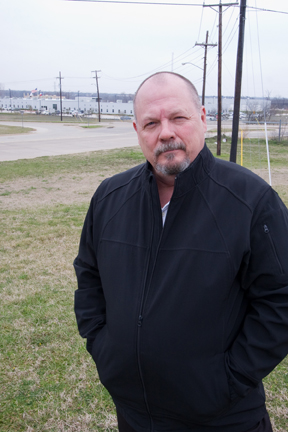 Two years ago, a case brought by property owners in Wise County who are worried about a proposed disposal well there resulted in a dramatic decision: A state appellate court ruled that the Railroad Commission is required to weigh the public interest in making decisions on gas well matters – and that the “public interest” can’t be defined only as the need for oil and gas production. The commission appealed the ruling, and the case is now before the Texas Supreme Court.
Two years ago, a case brought by property owners in Wise County who are worried about a proposed disposal well there resulted in a dramatic decision: A state appellate court ruled that the Railroad Commission is required to weigh the public interest in making decisions on gas well matters – and that the “public interest” can’t be defined only as the need for oil and gas production. The commission appealed the ruling, and the case is now before the Texas Supreme Court.
“This is a bad, bad, bad situation,” said Jim Popp, one of the key plaintiffs in the case and a zealous activist on gas well issues. “If they don’t do something” to change the way disposal wells and other gas drilling activity are regulated, he said, “we’re gonna have a hell of a problem with drinking water in Texas.”
In the Era case, in Wise County, in Panola County, and in Fort Worth, many citizens clearly feel that state regulatory agencies are not acting in the public interest and that health and safety issues are being ignored. Many of them use the word “jaded” – they no longer trust their governments on gas drilling issues.
“How do you fix an aquifer” if it becomes contaminated, asked Louis McBee. “What are we going to do, react after it happens?”
Not all the anger is directed at the industry or at regulators, however. People in the countryside are beginning to tire of folks in the city who are getting royalties and bonuses or, if not personal income, then the benefit of millions of dollars in taxes and gas well income paid to local governments – but who don’t want to see disposal wells in the city. In Panola County, the vast majority of the drilling waste put down the disposal wells comes from Louisiana, but Hudson said the local people see very little benefit coming to them from the industry.
“I look on TV, and I see these people who are worried about [drilling wastewater] disposal tanks,” Popp said. Rather than dealing with the waste near their cities, he said, “they want to load it onto trucks and bring it out to Wise County to injection wells here. And I’m tired of it.”
Brian Boerner hears that sentiment and understands it – and also understands the complexity of the problem. Once the gas drilling starts, there are no easy answers about what to do with the waste that results.
Fort Worth residents don’t rely on groundwater, Boerner said, “but we have to think about the people who do use it,” and the prospect of a permanent city moratorium that would send all the waste from Fort Worth wells out to the far less regulated countryside – indeed, to Wise County or Panola or to the Hess disposal well near Era.
He said the East First Street injection well is giving the city a lot of information to use in evaluating what its long-term policy should be. For instance, he said, it has revealed problems with current recycling technology when applied to the heavily salted drilling wastewater. And it has shown how imprecise the industry has been, up to now, in actually measuring the volumes of frac water being trucked from drilling site to disposal site. An evaporating unit has shown the challenges of dealing with the various chemicals in the frac wastewater – and how the salinity of the mix changes, for instance, when another well is being fracced nearby.
“Diligent monitoring,” he said, would “be the key to ensuring the health and safety of residents and property owners” around disposal facilities.
He said that saltwater pipelines, if they become part of the disposal formula here, would be regulated by the city – a question raised by citizens in other parts of North Texas, where centralized drilling waste treatment and disposal facilities are being considered. He also noted that operators of saltwater pipelines, unlike pipelines used to move the gas itself, don’t get to use the power of eminent domain, which means that putting together the property needed for such a line could be difficult.
One of the big remaining questions, Boerner said, is what the city should do if it ends the moratorium, allows disposal wells in Fort Worth under the regulation of a city ordinance, but then finds the Railroad Commission is willing to allow the wells to be drilled into geologic formations other than the Ellenburger.
One of the driving factors for drillers in deciding whether a well is profitable, he said, is the cost of diesel fuel for delivering the huge amounts of wastewater to offsite disposal facilities. If pipelines could take over part of that trip, he said, “that’s a whole new avenue of cost-effectiveness.”
On the other end of the cost-effectiveness formula, Boerner said that while he understands “that question of equity in shipping your waste somewhere else,” West Texas “has so much disposal capacity that is already permitted” by the state, that that is potentially an option.
“We have to figure out a happy medium – how to minimize the number of disposal wells and maximize their use, so we don’t have 100 wells that we have to monitor. A pipeline may make a whole lot of sense,” he said.
Boerner said the city can write requirements to make disposal wells less likely to cause environmental damage through surface leaks. And, he said, the city has the power to subject disposal wells to zoning restrictions, which it can’t do with
gas wells.
Fort Worth, he said, is the first major city that has had to try to figure this out. “We’re looking at things that really appeal to us and things that don’t,” he said.











